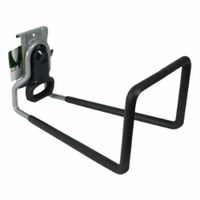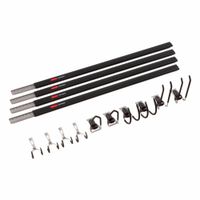Call +(254) 703 030 000 / 751 483 999 / 721 704 777
- Home
- Material Handling
- Storage Workspace
- Storage Panels Panel Racks
- Wall Mount Track Systems Racks Accessories
.....Read More
Frequently Asked Questions
What are the weight limits for wall-mount track systems?
The weight limits for wall-mount track systems vary based on several factors, including the type of track system, the materials used, the method of installation, and the wall structure. Generally, most wall-mount track systems are designed to support weights ranging from 50 to 200 pounds per linear foot. However, some heavy-duty systems can support up to 500 pounds or more per linear foot.
1. **Type of Track System**: Different track systems, such as single-track, double-track, or multi-track systems, have varying weight capacities. Heavy-duty tracks are specifically designed to hold more weight.
2. **Materials**: The materials used in the track system, such as aluminum, steel, or reinforced plastic, significantly affect the weight limit. Steel tracks typically support more weight than aluminum or plastic.
3. **Installation Method**: Proper installation is crucial for maximizing weight capacity. Tracks must be securely mounted to wall studs or other structural supports. Using appropriate anchors and fasteners is essential for ensuring stability.
4. **Wall Structure**: The type of wall (e.g., drywall, concrete, brick) also impacts the weight limit. Concrete and brick walls generally support more weight than drywall, which may require additional reinforcement.
5. **Manufacturer Specifications**: Always refer to the manufacturer's guidelines for specific weight limits and installation instructions. These specifications are based on rigorous testing and provide the safest parameters for use.
6. **Load Distribution**: Evenly distributing the weight across the track system helps prevent overloading any single point, which can lead to failure.
For precise weight limits, consult the product documentation or contact the manufacturer, as exceeding the recommended weight can lead to structural failure and potential injury.
How do I install a wall-mount track system on different wall types?
1. **Drywall:**
- **Tools Needed:** Drill, level, stud finder, screwdriver, anchors, screws.
- **Steps:**
1. Use a stud finder to locate studs.
2. Mark the desired height for the track.
3. Align the track with the marks and use a level to ensure it's straight.
4. Drill pilot holes into the studs.
5. Secure the track with screws into the studs.
6. If no studs are available, use drywall anchors for support.
2. **Concrete or Brick:**
- **Tools Needed:** Hammer drill, masonry bit, level, anchors, screws.
- **Steps:**
1. Mark the desired height for the track.
2. Use a level to ensure the track is straight.
3. Drill holes using a hammer drill with a masonry bit.
4. Insert masonry anchors into the holes.
5. Align the track and secure it with screws into the anchors.
3. **Plaster:**
- **Tools Needed:** Drill, level, stud finder, anchors, screws.
- **Steps:**
1. Use a stud finder to locate studs behind the plaster.
2. Mark the desired height for the track.
3. Align the track with the marks and use a level to ensure it's straight.
4. Drill pilot holes into the studs.
5. Secure the track with screws into the studs.
6. If no studs are available, use plaster anchors for support.
4. **Tile:**
- **Tools Needed:** Drill, tile bit, level, anchors, screws.
- **Steps:**
1. Mark the desired height for the track.
2. Use a level to ensure the track is straight.
3. Drill holes using a tile bit to avoid cracking.
4. Insert appropriate anchors.
5. Align the track and secure it with screws into the anchors.
Are wall-mount track systems compatible with all brands of hooks and accessories?
No, wall-mount track systems are not universally compatible with all brands of hooks and accessories. Compatibility depends on the design specifications and proprietary features of each brand. Many manufacturers design their track systems to work specifically with their own line of hooks and accessories, ensuring a secure fit and optimal functionality. This proprietary design can include unique locking mechanisms, specific dimensions, or weight-bearing capacities that are tailored to their products.
While some brands may offer universal or adaptable options that can accommodate accessories from other manufacturers, this is not always the case. Using non-compatible accessories can lead to issues such as poor fit, reduced weight capacity, or even damage to the track system or the accessories themselves. It is important to check the specifications and compatibility guidelines provided by the manufacturer before purchasing or attempting to use accessories from different brands.
For those seeking flexibility, some brands offer adapters or universal hooks that can fit multiple track systems, but these may not provide the same level of security or functionality as brand-specific options. To ensure compatibility and safety, it is advisable to use hooks and accessories that are specifically designed for the track system in question or to consult with the manufacturer for recommendations on compatible products.
Can wall-mount track systems be used outdoors?
Yes, wall-mount track systems can be used outdoors, but several factors must be considered to ensure their effectiveness and longevity. First, the materials used in the track system should be weather-resistant. Stainless steel, aluminum, or galvanized steel are ideal choices as they resist rust and corrosion. Additionally, the hardware, such as screws and brackets, should also be made from weather-resistant materials.
The design of the track system should allow for proper drainage to prevent water accumulation, which can lead to rust or damage. It's also important to ensure that the track system is securely mounted to withstand wind and other environmental forces. The mounting surface should be stable and capable of supporting the weight and stress of the track system and any items it holds.
Consider the climate and environmental conditions of the installation area. In regions with high humidity, salt air, or extreme temperatures, additional protective coatings or treatments may be necessary to extend the lifespan of the track system.
Regular maintenance is crucial for outdoor installations. This includes periodic inspections for signs of wear, rust, or damage, and cleaning to remove dirt and debris that can affect the system's functionality.
Finally, ensure that the track system is designed for outdoor use by consulting the manufacturer's specifications and guidelines. Some systems are specifically engineered for outdoor environments and come with warranties that cover outdoor use. By selecting the right materials, design, and maintenance practices, wall-mount track systems can be effectively used outdoors.
How do I determine the right configuration for my storage needs?
1. **Assess Storage Requirements**: Identify the type of data (structured, unstructured), volume, and growth rate. Consider data retention policies and compliance requirements.
2. **Performance Needs**: Determine the IOPS (Input/Output Operations Per Second), latency, and throughput requirements based on application demands.
3. **Scalability**: Choose a solution that can scale vertically (adding more resources to existing systems) or horizontally (adding more systems) as your data grows.
4. **Data Access Patterns**: Analyze how frequently data is accessed. Use tiered storage for hot, warm, and cold data to optimize costs and performance.
5. **Redundancy and Reliability**: Decide on the level of redundancy needed (RAID configurations, replication) to ensure data availability and protection against failures.
6. **Budget Constraints**: Balance between performance, capacity, and cost. Consider Total Cost of Ownership (TCO) including hardware, software, and operational expenses.
7. **Security and Compliance**: Ensure the storage solution meets security standards and compliance requirements (encryption, access controls).
8. **Integration and Compatibility**: Ensure compatibility with existing infrastructure and ease of integration with current systems and applications.
9. **Vendor Support and Ecosystem**: Evaluate vendor support, service level agreements (SLAs), and the ecosystem for additional tools and services.
10. **Future-Proofing**: Consider emerging technologies and trends (cloud storage, NVMe, AI-driven storage management) to ensure long-term viability.
11. **Testing and Validation**: Conduct proof-of-concept tests to validate performance, reliability, and compatibility with your workloads.
12. **Feedback and Iteration**: Gather feedback from stakeholders and continuously monitor and adjust the configuration as needs evolve.
What tools are required for installing wall-mount track systems?
To install wall-mount track systems, you will need the following tools:
1. **Measuring Tape**: For accurate measurements of the wall and track system placement.
2. **Level**: To ensure the track is installed straight and even.
3. **Pencil or Marker**: For marking drill points and alignment lines on the wall.
4. **Stud Finder**: To locate wall studs for secure mounting.
5. **Drill**: For making holes in the wall where the track will be mounted.
6. **Drill Bits**: Appropriate sizes for pilot holes and wall anchors.
7. **Screwdriver**: For tightening screws; a power screwdriver can speed up the process.
8. **Wall Anchors**: If mounting on drywall without studs, to provide additional support.
9. **Screws**: Typically provided with the track system, but ensure they are suitable for your wall type.
10. **Hammer**: To tap in wall anchors if necessary.
11. **Saw or Hacksaw**: If the track needs to be cut to fit the wall space.
12. **Safety Gear**: Such as goggles and gloves to protect against dust and sharp edges.
13. **Ladder or Step Stool**: To reach higher areas of the wall safely.
14. **Cleaning Supplies**: To clean the wall surface before installation for better adhesion and to remove dust after drilling.
These tools will help ensure a secure and level installation of your wall-mount track system.
How do I maintain and clean wall-mount track systems and accessories?
To maintain and clean wall-mount track systems and accessories, follow these steps:
1. **Regular Dusting**: Use a microfiber cloth or a duster to remove dust from the tracks and accessories. This prevents buildup that can affect functionality.
2. **Deep Cleaning**: Periodically, use a damp cloth with mild soap and water to clean the tracks and accessories. Avoid harsh chemicals that can damage finishes.
3. **Inspect for Damage**: Regularly check for any signs of wear, rust, or damage. Tighten any loose screws or brackets to ensure stability.
4. **Lubrication**: Apply a silicone-based lubricant to the tracks to ensure smooth operation. Avoid oil-based lubricants as they can attract dust and dirt.
5. **Organize Accessories**: Reorganize and declutter accessories to maintain balance and prevent overloading, which can strain the system.
6. **Check Alignment**: Ensure that tracks and accessories are properly aligned. Misalignment can cause wear and reduce efficiency.
7. **Clean Accessories**: Detach accessories like hooks or shelves and clean them separately with mild soap and water. Dry thoroughly before reattaching.
8. **Avoid Moisture**: Keep the area dry to prevent rust and corrosion, especially in humid environments.
9. **Use Protective Pads**: For accessories that hold heavy items, use protective pads to prevent scratches and distribute weight evenly.
10. **Regular Maintenance Schedule**: Establish a routine maintenance schedule to ensure longevity and optimal performance of the system.
By following these steps, you can maintain the functionality and appearance of your wall-mount track systems and accessories effectively.

